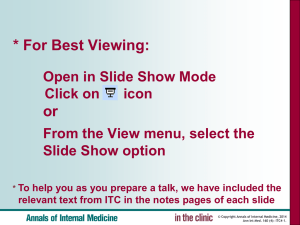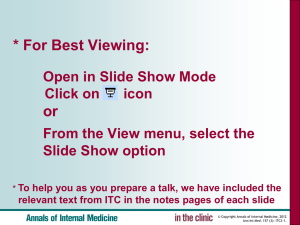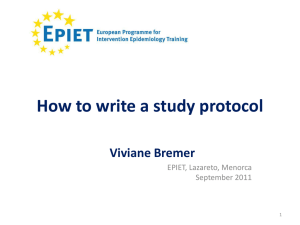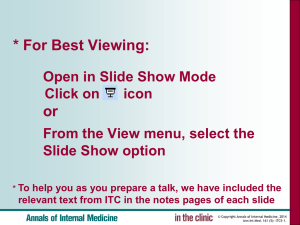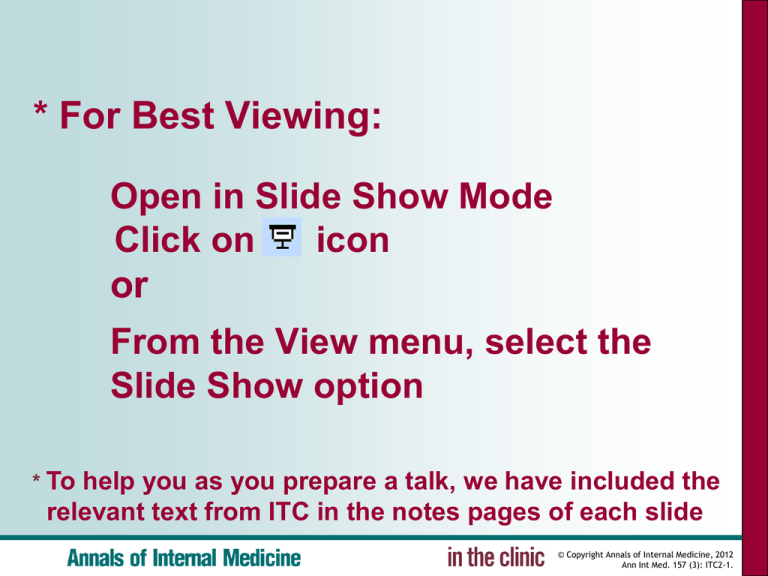
* For Best Viewing:
Open in Slide Show Mode
Click on
icon
or
From the View menu, select the
Slide Show option
* To help you as you prepare a talk, we have included the
relevant text from ITC in the notes pages of each slide
© Copyright Annals of Internal Medicine, 2012
Ann Int Med. 157 (3): ITC2-1.
in the clinic
Hepatitis C
© Copyright Annals of Internal Medicine, 2012
Ann Int Med. 157 (3): ITC2-1.
Terms of Use
The In the Clinic® slide sets are owned and copyrighted by the
American College of Physicians (ACP). All text, graphics,
trademarks, and other intellectual property incorporated into the
slide sets remain the sole and exclusive property of ACP. The slide
sets may be used only by the person who downloads or purchases
them and only for the purpose of presenting them during not-forprofit educational activities. Users may incorporate the entire slide
set or selected individual slides into their own teaching
presentations but may not alter the content of the slides in any way
or remove the ACP copyright notice. Users may make print copies
for use as hand-outs for the audience the user is personally
addressing but may not otherwise reproduce or distribute the slides
by any means or media, including but not limited to sending them as
e-mail attachments, posting them on Internet or Intranet sites,
publishing them in meeting proceedings, or making them available
for sale or distribution in any unauthorized form, without the
express written permission of the ACP. Unauthorized use of the In
the Clinic slide sets constitutes copyright infringement.
© Copyright Annals of Internal Medicine, 2012
Ann Int Med. 157 (3): ITC2-1.
What factors increase the risk for HCV
infection?
Percutaneous exposure to infected blood
Remote or long-term injection drug
Blood transfusion
Tattoo or piercing with contaminated instruments
Accidental needle-stick (health care workers)
Reuse of needles and syringes
Hemodialysis (U.S. rate of infection: 8.9%)
Sexual intercourse with HCV-infected person
Mother-to-child transmission
© Copyright Annals of Internal Medicine, 2012
Ann Int Med. 157 (3): ITC2-1.
How can individuals, including those who
live with an infected individual, reduce risk?
Avoid high-risk behaviors
Treatment programs for support
Needle-exchange programs
Use condoms
Advised for patients with multiple sex partners
Don’t share razors, toothbrushes, nail clippers
Follow infection control practices in health care setting
Always use new needle and new syringe to access
medication from multidose vials
© Copyright Annals of Internal Medicine, 2012
Ann Int Med. 157 (3): ITC2-1.
CLINICAL BOTTOM LINE: Prevention…
Main risk factor for infection: percutaneous exposure
Transfusion of blood products
Injection drug use
Hemodialysis
Other risk factors: sexual transmission, mother-child
transmission
To prevent infection, avoid high-risk behaviors
Don’t share or reuse needles
Use condoms
Use infection control practices in health care settings
© Copyright Annals of Internal Medicine, 2012
Ann Int Med. 157 (3): ITC2-1.
Who should clinicians screen for HCV infection?
Those with risk factors
Injection drug use (past or present)
Receipt of clotting factor concentrates before 1987; or of
blood or blood components or solid-organ transplantation
before July 1992; or of blood from HCV-positive donor
Long-term hemodialysis treatment
Repeatedly elevated serum alanine transaminase levels
Specific high-risk exposure to known HCV-positive blood
Needle-sticks or other sharp exposure; mucosal exposure
HIV infection
Being the child of HCV-positive woman
History of multiple sex partners or STDs
Being born between 1945-1965 (new CDC recommendation)
© Copyright Annals of Internal Medicine, 2012
Ann Int Med. 157 (3): ITC2-1.
What test should clinicians use for screening?
Use ELISA to test for antibody to HCV
Sensitivity 98.9%-100%
Specificity 99.3%-100%
(When performed with second- or third-generation assays)
© Copyright Annals of Internal Medicine, 2012
Ann Int Med. 157 (3): ITC2-1.
CLINICAL BOTTOM LINE: Screening…
Screen all persons with risk factors for HCV antibody
Including anyone born from 1945 to 1965
Use ELISA test for HCV antibody
© Copyright Annals of Internal Medicine, 2012
Ann Int Med. 157 (3): ITC2-1.
What is the clinical spectrum of HCV infection?
Acute infection
Often asymptomatic or nonspecific: fatigue, nausea,
abdominal pain, flu-like
Jaundice
Acute liver failure uncommon
Chronic infection (develops in 74%-86% over time)
Symptoms: Fatigue, jaundice, lower-extremity edema,
ascites, altered mental status, GI bleeding
Abnormal liver tests
Cirrhosis, portal hypertension
Hepatocellular carcinoma
© Copyright Annals of Internal Medicine, 2012
Ann Int Med. 157 (3): ITC2-1.
Extrahepatic Manifestations
Arthritis
Porphyria cutanea tarda
Leukocytoclastic vasculitis
Lichen planus
Raynaud phenomenon
The sicca syndrome
Idiopathic thrombocytopenic purpura
Membranoproliferative glomerulonephritis
Membranous nephropathy
Hypo/hyperthyroidism
Diabetes mellitus
Essential mixed cryoglobulinemia
Monoclonal gammopathy
Non-Hodgkin lymphoma
© Copyright Annals of Internal Medicine, 2012
Ann Int Med. 157 (3): ITC2-1.
What laboratory tests should clinicians use?
Positive antibody to HCV on ELISA ?
Measure HCV RNA by PCR to confirm chronic infection
Note: quantitative viral load doesn’t predict HCV severity
(correlates poorly with hepatic histology)
Considering therapy ?
Obtain HCV genotype (affects Rx response, regimen, duration
Most other liver function studies lack specificity
Reserve other lab tests for those with evidence of cirrhosis or
extrahepatic manifestations of HCV
© Copyright Annals of Internal Medicine, 2012
Ann Int Med. 157 (3): ITC2-1.
When should clinicians consider liver biopsy?
Once infection confirmed with HCV RNA testing
Identifies those most at risk for disease progression
Moderate-to-severe fibrosis ? Consider treatment
Minimal or no fibrosis ? May defer treatment
Biopsy may show significant fibrosis even if alanine
aminotransferase levels normal
Helps assess risk vs. benefit of treatment
Limitations: sampling error + interobserver variability
Repeatedly test hepatic histology over time (to lower
error rate and variability + estimate progression)
© Copyright Annals of Internal Medicine, 2012
Ann Int Med. 157 (3): ITC2-1.
What other liver conditions have similar
clinical presentations?
Differential diagnosis is broad
Because symptoms & lab abnormalities nonspecific
Consider HCV when any liver disease causes mild-tomoderate transaminase level elevations or cirrhosis
Infection can occur in patients with other liver diseases
Testing for hepatitis C may be warranted even when
alternative diagnosis seems secure
© Copyright Annals of Internal Medicine, 2012
Ann Int Med. 157 (3): ITC2-1.
CLINICAL BOTTOM LINE: Diagnosis…
Chronic HCV infection usually asymptomatic
Liver function tests often abnormal
Extrahepatic manifestations or portal hypertension or
hepatocellular carcinoma may be present
To diagnose: Use ELISA to test for antibody to HCV
To confirm: use PCR to measure HCV RNA
Consider liver biopsy
Evaluates degree of fibrosis
Guides treatment decisions
© Copyright Annals of Internal Medicine, 2012
Ann Int Med. 157 (3): ITC2-1.
Are lifestyle interventions helpful in the
management of hepatitis C infection?
Abstain from alcohol
Increased alcohol hastens development of cirrhosis in
HCV-infected individuals
Avoid hepatotoxic drugs
Normal doses of acetaminophen: not contraindicated
Beware overdose thru heavy acetaminophen use
Use care with NSAIDs, which are risky in cirrhosis
Follow low-sodium diet (if cirrhosis and ascites present)
Don’t restrict protein with cirrhosis (malnutrition risk)
© Copyright Annals of Internal Medicine, 2012
Ann Int Med. 157 (3): ITC2-1.
Are complementary-alternative therapies
useful?
Herbal remedies don’t improve the outcome of infection
Avoid herbal remedies known to be hepatotoxic
Chaparral
Leaf germander
Jin bu huan
Mistletoe
Pennyroyal
Traditional Chinese herbs
© Copyright Annals of Internal Medicine, 2012
Ann Int Med. 157 (3): ITC2-1.
When should clinicians consider drug therapy?
If patient has no contraindications (see next slide) and…
Compensated liver disease and
Detectable serum HCV RNA
Alternate strategy: track liver disease progression
Biopsy every 3 to 5 years
Both strategies have merit
Given substantial side effects of drug treatment
Weigh risk for decompensation of liver disease against
decreased Rx response in advanced fibrosis or cirrhosis
Discuss risks & benefits of each strategy with patients
© Copyright Annals of Internal Medicine, 2012
Ann Int Med. 157 (3): ITC2-1.
Contraindications to pegIFN and ribavirin Rx
Uncontrolled major depression, particularly suicide attempts
Autoimmune hepatitis or other autoimmune disorders
Bone marrow, lung, heart, or kidney transplantation
Severe hypertension, CHD, CHF, CVD, or other serious
nonliver disorders likely to reduce life expectancy
Renal insufficiency
Noncompliance with office visits or medications
Decompensated cirrhosis or hepatocellular carcinoma
Pregnancy or inability to practice birth control methods
Severe anemia, thrombocytopenia, or granulocytopenia
Controversial contraindications: Active alcohol use, illicit drug use
© Copyright Annals of Internal Medicine, 2012
Ann Int Med. 157 (3): ITC2-1.
How should clinicians choose from among
available treatment regimens?
Backbone treatment for chronic HCV: pegIFN + ribavirin
pegIFN: subcutaneous injections 1x/wk
Ribavirin: by mouth in divided doses 2x/d
Genotype determines regimen, duration, likely response
Genotype 1
Standard care now includes boceprevir / telaprevir
Regimen improves response rate, reduces treatment time
Genotypes 2 – 6
PegIFN + ribavirin: 24 – 48 wks (depending on genotype)
HIV co-infection
Treat HCV if HIV status is stable (pegIFN-ribavirin only)
© Copyright Annals of Internal Medicine, 2012
Ann Int Med. 157 (3): ITC2-1.
Which vaccinations should patients receive?
Hepatitis A vaccine
Ask about prior vaccination / exposure to hepatitis A
Vaccinating empirically may be more cost-effective than
measuring for antibodies
Hepatitis B vaccine
Ask about prior vaccination / exposure to hepatitis B
If no vaccination / exposure: measure anti-HBs
If negative: administer HBV series
Annual influenza vaccine
Pneumococcal vaccine
For all patients with cirrhosis, regardless treatment for HCV
© Copyright Annals of Internal Medicine, 2012
Ann Int Med. 157 (3): ITC2-1.
What is appropriate clinical management for
patients with suboptimal response to therapy?
Null response: <2-log reduction in HCV RNA by week 12 when
treated with interferon-α–based regimen
Partial response: >2-log reduction by week 12, but detectable
Relapse: undetectable at treatment end; detectable in follow-up
Evaluate therapy
Perform histologic examination of liver to guide treatment
Genotype 1: if pegIFN-ribavirin regimen failed, retreat with
addition of protease inhibitor
if protease inhibitor failed, don’t try different one
(refer to hepatologist for alternative approaches)
Genotype 2-6: if patient nonadherent, can try a 2nd course
re-treat if previous dosing was incorrect of if
inappropriate dose reductions occurred
© Copyright Annals of Internal Medicine, 2012
Ann Int Med. 157 (3): ITC2-1.
What are the side effects of hepatitis C drugs?
Interferon
Fatigue
Flu-like syndrome
Nausea and vomiting
Headaches
Low-grade fever
Weight loss
Irritability
Depression
Hair thinning
Ribavirin
Hemolytic
anemia
Fatigue
Pruritus
Rashes
Cough, dyspnea,
bronchospasm
Boceprevir
Anemia
Dysgeuesia
Injection site Irritation
Bone marrow
suppression
Telaprevir
Anemia
Rash
GI side effects
Uncommon side
effects: interferon
combination
Autoimmune
thyroiditis
Seizures
Suicidal ideation
or attempts
Retinopathy
Sepsis
Myocardial
infarction
Pulmonary
fibrosis
© Copyright Annals of Internal Medicine, 2012
Ann Int Med. 157 (3): ITC2-1.
How can the side effects be managed?
Anemia: reduce ribavirin dose
Thrombocytopenia: try thrombopoietin-receptor
agonists
Be alert to possible hepatotoxity, thromboembolic
complications
Don’t reduce or interrupt protease inhibitors
Risk for viral resistance
© Copyright Annals of Internal Medicine, 2012
Ann Int Med. 157 (3): ITC2-1.
How should clinicians evaluate the
response to therapy?
Baseline: Assess HCV RNA titers at initiation of therapy
Goal: Undetectable viral load for 6 mos after therapy end (SVR)
Genotype 1
Boceprevir + pegIFN-ribavirin: assess titers @ 8, 12, 24 weeks
>100 IU/mL at week 12 or detectable at week 24: stop Rx
Undetectable at week 8 & 24: ? shorten course of therapy
Prior null responders: treat 48 weeks regardless response
Telaprevir + pegIFN-ribavirin: assess titers @ 4, 12, 24 weeks
>1000 IU/mL at week 4 & 12 or detectable at 24: stop Rx
Undetectable at week 4 & 12: treat 24 weeks if no cirrhosis
and treatment-naïve, or if patient previously relapsed
With cirrhosis, prior partial responders or nonresponders:
treat for full 48 weeks
© Copyright Annals of Internal Medicine, 2012
Ann Int Med. 157 (3): ITC2-1.
Genotypes 2 - 3
Assess titers after week 24 of pegIFN-ribavirin therapy
Consider assessing at week 12:
Early virologic response: ≥2-log reduction in titers
If patients don’t achieve, discontinue Rx
If patients do achieve, then titers should be undetectable
by 24 weeks (if not, halt treatment)
© Copyright Annals of Internal Medicine, 2012
Ann Int Med. 157 (3): ITC2-1.
Are there other drug regimens with
documented effectiveness?
Interferon-free regimens
Would be revolutionary advance in treatment
Studies still needed (? best combination, duration)
Concern: relapse after completion of therapy
? Delay treatment for mild disease until newer drug
combinations available
Especially significant for regimens w/o pegIFN
© Copyright Annals of Internal Medicine, 2012
Ann Int Med. 157 (3): ITC2-1.
Is it possible to cure hepatitis C infection?
Cure = SVR to interferon-based therapies ≥2 years
Relapse still possible but unlikely
SVR associated with decreased liver-related morbidity and
mortality
Note: Patients can be re-infected after successful treatment
(antibody isn’t protective)
© Copyright Annals of Internal Medicine, 2012
Ann Int Med. 157 (3): ITC2-1.
When is liver transplantation indicated?
Model for End-Stage Liver Disease (MELD) score ≥10
or
First major portal hypertension complication occurs
Ascites, hepatic encephalopathy, variceal bleeding
or
Hepatocellular carcinoma
© Copyright Annals of Internal Medicine, 2012
Ann Int Med. 157 (3): ITC2-1.
What is the risk for hepatocellular carcinoma?
Occurrence: 3% per year after development of cirrhosis
Surveillance: ultrasonography every 6 months
Serum α-fetoprotein no longer recommended
© Copyright Annals of Internal Medicine, 2012
Ann Int Med. 157 (3): ITC2-1.
When is specialty consultation indicated?
Hepatologist or infectious disease specialist
To distinguish HCV infection from other liver diseases
To determine need for liver biopsy
To guide next step if nonresponse to pegIFN-α - ribavirin
To evaluate for liver transplantation
© Copyright Annals of Internal Medicine, 2012
Ann Int Med. 157 (3): ITC2-1.
CLINICAL BOTTOM LINE: Treatment…
Individualize decisions on treatment based on…
Stage of disease
Clinical and lab evaluation
Patient preference; any Rx contraindications
Standard treatment: pegIFN-α and ribavirin
Genotype determines dose & duration
For patients with genotype 1: boceprevir or telaprevir
approved for addition to the treatment regimen
© Copyright Annals of Internal Medicine, 2012
Ann Int Med. 157 (3): ITC2-1.





